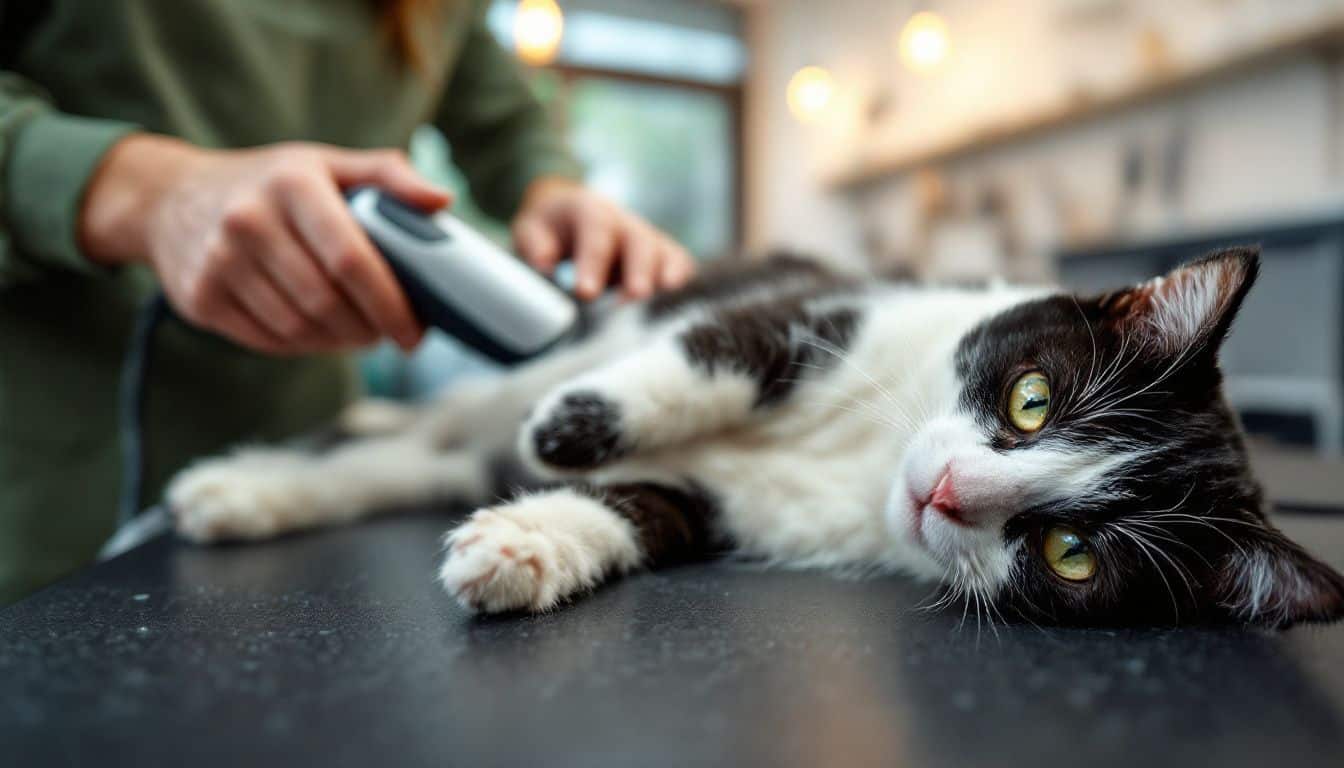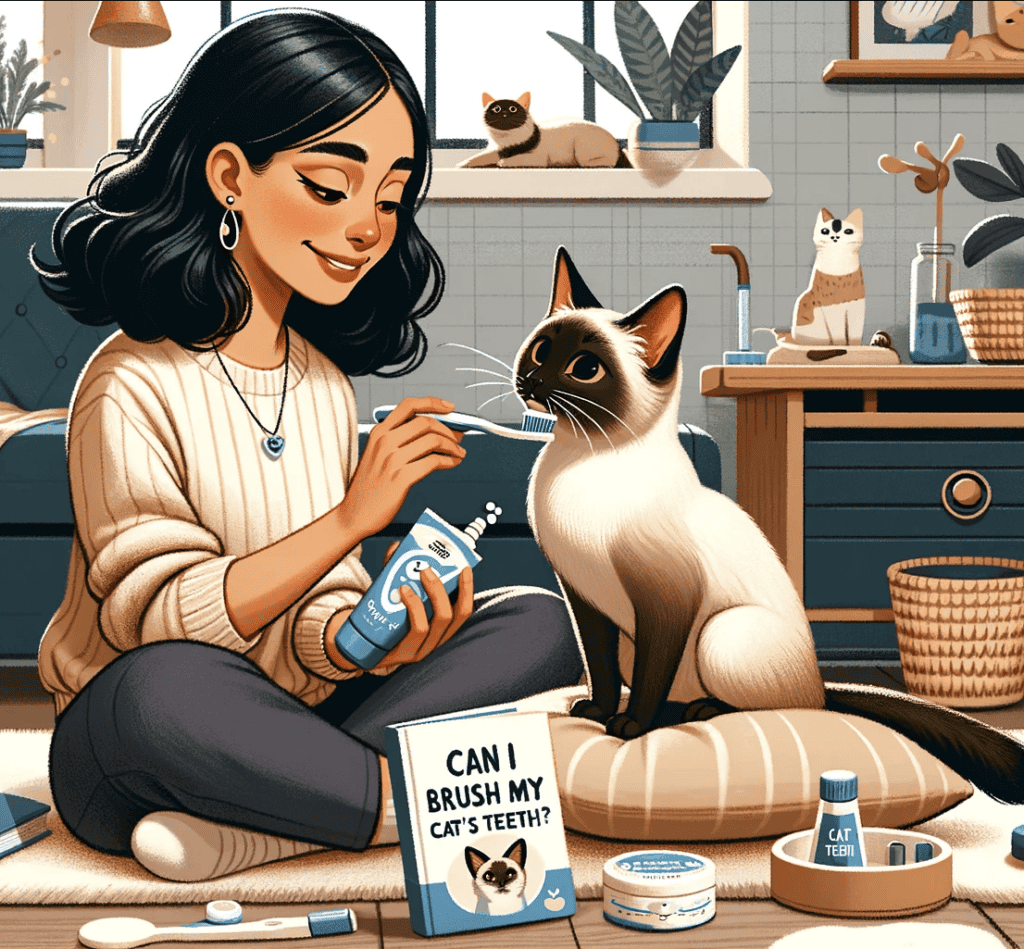
Ensuring your cat’s hygiene is essential for their comfort and overall health. While cats naturally groom themselves, spending nearly 25–30% of their time on this activity, some may need extra help, especially long-haired breeds or older cats who struggle to keep their rear ends clean. In this post, you will learn how to shave a cat’s bum properly, which can prevent issues like matting, discomfort, or feces sticking to the fur, which will also ensure your cat remains clean and happy.
If you’re unsure about how to shave a cat bum, don’t worry—it’s a manageable process with the right tools and preparation. Patience is the key ingredient. Approach the task calmly, and your cat will feel more at ease throughout the grooming session.
What You Need to Shave a Cat’s Bum
Essential Tools for the Job
To shave your cat’s bum safely and effectively, you need the right tools. Each item plays a specific role in ensuring the process is smooth and stress-free for both you and your cat.
-
Pet-safe clippers or trimmers with a low-noise setting: Cats are sensitive to loud noises. A quiet clipper minimizes stress and helps your cat stay calm during grooming. Look for clippers designed specifically for pets, which are safer and more efficient for delicate areas.
-
Blunt-nose scissors for trimming longer fur safely: These scissors reduce the risk of accidental cuts. They are ideal for trimming long fur before using clippers, especially if the coat is matted or tangled.
-
A comb or brush to detangle fur before shaving: A wide-toothed comb or de-shedding tool works well to remove knots and tangles. This step ensures the clippers glide smoothly through the fur.
-
Sanitary gloves and a mask for hygiene: Protect yourself from bacteria and allergens by wearing gloves and a mask. This is especially important when dealing with fecal matter stuck in the fur.
-
Towels, newspapers, or butcher paper to manage mess: Lay these under your cat to catch loose fur and debris. This makes cleanup easier and keeps your workspace tidy.
-
Treats or calming sprays to keep your cat relaxed: Use calming sprays formulated for cats to create a soothing environment. Treats act as positive reinforcement, helping your cat associate grooming with rewards.
Preparing the Space
Creating the right environment is just as important as having the right tools. A calm and organized space ensures your cat feels secure and reduces the chances of accidents.
Choose a quiet, well-lit area with minimal distractions
Pick a room where your cat feels comfortable. Avoid noisy or high-traffic areas. Good lighting helps you see the fur clearly, reducing the risk of missing spots or causing injury.
Use a non-slip mat or towel to keep your cat secure
Place a non-slip mat or towel on the surface where you’ll groom your cat. This prevents slipping and gives your cat a stable base on which to sit or lie.
Keep all tools within easy reach to avoid interruptions
Arrange your tools neatly before starting. Having everything within arm’s reach allows you to focus on your cat without unnecessary pauses. This keeps the process efficient and minimizes stress for both of you.
Quick Checklist for Your Grooming Space:
Quiet and well-lit room
Non-slip mat or towel
Tools arranged within reach
Calming sprays or treats nearby
Preparing thoroughly makes the process smoother and ensures your cat feels safe and cared for throughout the grooming session.
How to Know If Your Cat Can Be Shaved?
Assessing Your Cat’s Temperament
Understanding your cat’s personality is essential before attempting any grooming. Cats react differently to grooming based on their temperament, past experiences, and comfort levels.
Signs your cat may tolerate at-home grooming
Some cats remain calm and cooperative during grooming sessions. If your cat enjoys being handled, purrs when brushed, or stays relaxed in your presence, they may tolerate at-home grooming. Look for signs like a steady posture, soft eyes, and a lack of resistance when you touch sensitive areas like their tail or hindquarters. These behaviors indicate that your cat feels safe and trusts you.
To make the process smoother, gradually introduce grooming tools. Let your cat sniff the clippers or scissors before using them.
Reward calm behavior with treats or gentle petting. This positive reinforcement builds trust and helps your cat associate grooming with a pleasant experience.
When to consider professional grooming for stressed or aggressive cats
If your cat shows signs of stress or aggression, such as hissing, swatting, or trying to escape, it’s best to avoid grooming them at home. Cats with high anxiety levels may become overwhelmed, making the process unsafe for both of you. Professional groomers specialize in handling such situations. They use techniques to calm nervous cats and ensure their safety throughout the session. Professional grooming is particularly beneficial for cats with severe matting or long-haired breeds that require extra care.
Experts can handle challenging cases while minimizing discomfort for your cat. If your cat has a history of biting or scratching during grooming, seeking professional help is the safest option.
Evaluating Your Own Comfort Level
Your confidence and ability to handle your cat during grooming play a significant role in the success of the process. Grooming requires patience, steady hands, and a calm demeanor.
Are you confident handling your cat during grooming?
Ask yourself if you feel comfortable managing your cat’s movements using grooming tools. If you’ve never groomed a cat before, start with small steps like brushing their fur or trimming nails. These activities help you build confidence and understand your cat’s reactions.
Always prioritize your cat’s comfort and safety. If you feel unsure about using clippers or scissors near sensitive areas, take a step back and reassess.
When to seek help from a vet or professional groomer
Don’t hesitate to seek assistance if you feel nervous or lack experience. Vets and professional groomers have the expertise to handle grooming tasks efficiently. They can also provide guidance on maintaining your cat’s hygiene at home.
Consulting a vet for cats with medical conditions or skin sensitivities ensures that grooming is done safely and appropriately.
How to Shave Cat Bum: Step-by-Step Instructions
Step 1: Calm and Prepare Your Cat
Before you begin, creating a relaxed environment for your cat is essential. Cats are sensitive to changes in their surroundings, so taking the time to prepare them will make the process smoother.
Use treats, calming sprays, or gentle petting to relax your cat.
Start by offering your cat their favorite treats or using a calming spray designed for pets. These sprays often contain pheromones that help reduce anxiety. Speak softly and pet your cat gently to reassure them. If your cat seems nervous, give them time to settle before proceeding.
Brush the area to remove tangles and assess the fur condition.
Use a wide-toothed comb or a de-shedding brush to detangle the fur around the bum area. This step prevents clippers from snagging on knots, which could cause discomfort.
While brushing, check for any signs of irritation, redness, or matting that may require extra care during shaving.
Step 2: Position Your Cat Safely
Proper positioning is crucial to ensure your cat feels secure and to avoid accidental injuries during the process.
Hold your cat gently but securely, or enlist a helper.
Place your cat on a stable surface, such as a table covered with a non-slip mat or towel. Hold them gently but firmly to prevent sudden movements. If your cat tends to squirm, ask a friend or family member to assist by holding your cat while you shave.
Ensure your cat feels stable and supported on the surface.
Make sure your cat’s paws are resting comfortably on the surface. A wobbly or slippery surface can make your cat feel uneasy, increasing their stress levels. Stability is key to keeping your cat calm and cooperative.
Step 3: Shave the Area
You can begin shaving when your cat is calm and securely positioned. Follow these steps to ensure a safe and effective trim.
Use clippers on the lowest setting, shaving toward hair growth.
Choose pet-safe clippers with a low-noise setting to minimize stress. Start shaving toward the hair growth to avoid pulling or irritating the skin. Work slowly and carefully, focusing on small sections at a time. Keep the clippers slightly above the skin to prevent nicks or cuts.
Trim longer fur with blunt-nose scissors if necessary.
If the fur is too long or matted for clippers to handle, use blunt-nose scissors to trim it down first. Hold the scissors with the tips pointing away from your cat’s skin to avoid accidental injuries. Cut small amounts of fur at a time for better control.
Take breaks if your cat becomes agitated or stressed.
Pay attention to your cat’s body language. If they start to squirm, meow loudly, or show signs of distress, pause the session. Allow your cat to relax before continuing. Rushing the process can lead to mistakes or injuries, so patience is essential.
Step 4: Clean and Inspect the Area
After shaving, cleaning your cat’s bum thoroughly and inspecting the area for any issues is essential. This step ensures your cat remains comfortable and avoids skin irritations or infections.
Wipe the area with a damp cloth to remove loose fur.
Use a soft, damp cloth to clean your cat’s bum gently. This removes any loose fur, shaving debris, or dirt left behind during grooming.
Make sure the cloth is lukewarm to avoid startling your cat. Wipe in smooth, gentle motions to keep your cat calm and prevent discomfort. If you notice any stubborn residue, dampen the cloth slightly and continue cleaning carefully.
Check for any signs of irritation, redness, or cuts.
Once the area is clean, carefully inspect your cat’s skin. Look for redness, small cuts, or signs of irritation. These issues can occur if your cat moves unexpectedly during shaving or if the clippers are too close to the skin.
If you spot any minor nicks, apply a pet-safe antiseptic to prevent infection. For more severe cuts or persistent redness, consult your veterinarian immediately.
Quick Checklist for Inspection:
Redness or swelling
Small cuts or abrasions
Signs of discomfort when touching the area
Regular inspection helps you catch potential problems early. It also ensures that your efforts to clean your cat’s butt contribute to their overall hygiene and well-being.
Post-Shaving Care for Your Cat
Proper post-shaving care ensures your cat remains comfortable and avoids potential skin issues. This step is just as important as the shaving process itself. By taking a few simple actions, you can help your cat recover quickly and maintain its hygiene.
Cleaning and Monitoring the Area
Apply a pet-safe antiseptic to minor nicks or cuts.
After shaving, inspect your cat’s skin for minor nicks or cuts. If you notice any, apply a pet-safe antiseptic to the affected area. This prevents infections and promotes faster healing.
Use a cotton ball or soft cloth to dab the antiseptic gently.
Avoid using products with alcohol, as they can irritate your cat’s sensitive skin. Always check the label to ensure the antiseptic is safe for pets.
Monitor the area for redness, swelling, or signs of infection.
Over the next few days, monitor the shaved area for redness, swelling, or unusual discharge, which could indicate an infection. If you notice any of these signs, consult your veterinarian immediately. Regular monitoring helps you catch potential problems early and ensures your cat stays healthy.
A clean and irritation-free area will make your cat feel more at ease.
Rewarding and Comforting Your Cat
Offer treats and praise to create a positive experience.
Once the grooming session is complete, reward your cat with its favorite treats. This reinforces positive behavior and helps your cat associate grooming with a pleasant experience.
Speak to your cat calmly and soothingly, offering plenty of praise.
Positive reinforcement builds trust and makes future grooming sessions easier for both of you.
Allow your cat to relax in a familiar, comfortable space.
After shaving, let your cat rest in a quiet and familiar spot. This could be their favorite bed, a cozy blanket, or a sunny corner of the house. Avoid handling them too much immediately after grooming, as they may need time to decompress. A relaxed environment helps your cat recover from any stress they may have experienced during the process. Taking care of your cat after grooming is essential for their well-being.
With proper cleaning, monitoring, and comfort, you can ensure your furry friend stays happy and healthy. Post-shaving care is integral to cat grooming, strengthening the bond between you and your pet.
Potential Challenges and Common Mistakes to Avoid
Shaving your cat’s bum can be a delicate process. While it may seem straightforward, unexpected challenges can arise, especially if your cat is uncooperative or the fur is difficult to manage. Knowing these challenges and steering clear of typical mistakes will help you adhere to good shaving practices and ensure a safe and relaxing experience for you and your cat.
Challenges You Might Face
Managing a squirmy or stressed cat during the process
Cats are naturally independent creatures, and many dislike being restrained. If your cat becomes squirmy or stressed during grooming, it can make the process more difficult and increase the risk of injury. To manage this, create a calm environment before starting. Use calming sprays or pheromone diffusers to help your cat relax. Offering treats during breaks can also keep your cat engaged and cooperative.
If your cat continues to resist, consider breaking the session into smaller steps. Grooming in short intervals allows your cat to adjust to the process without feeling overwhelmed. Enlisting the help of a friend or family member to hold your cat gently can also make the task easier.
Dealing with long or matted fur that’s difficult to shave
Long-haired cats or those with matted fur present unique challenges. Mats can pull on the skin, causing discomfort or even pain. Attempting to shave over mats without proper preparation can lead to nicks or cuts.
Always detangle the fur first using a wide-toothed comb or de-matting tool to address this. Use blunt-nose scissors to carefully trim them down for severe mats before shaving. If the mats are too close to the skin or too dense to handle safely, consult a professional groomer or veterinarian. They have the expertise to remove mats without causing harm. Following vet-approved steps ensures your cat’s safety and comfort throughout grooming.
Common Mistakes to Avoid
Using human clippers or scissors, which can harm your cat
One of the most common mistakes is using tools designed for humans instead of pets. Human clippers are unsuitable for a cat’s delicate skin and can cause irritation or injury. Similarly, sharp scissors increase the risk of accidental cuts.
Always use pet-safe clippers with a low-noise setting and blunt-nosed scissors to trim sensitive areas like the bum. These tools are specifically designed to handle sensitive areas.
Rushing the process and causing injury or stress
Patience is critical when performing a sanitary cut. Rushing through the process can lead to mistakes, such as uneven shaving or accidental nicks. Cats are highly sensitive to stress, and a hurried approach can make them anxious or agitated. Work in small sections, ensuring your cat remains calm and comfortable.
If your cat shows distress, pause the session and allow them to relax before continuing.
Ignoring signs of discomfort or stress in your cat
Cats communicate their discomfort through body language. Ignoring these signs can escalate their stress and make the process more challenging. Watch for cues like flattened ears, tail flicking, or vocalizations. If your cat becomes overly stressed, stop immediately and reassess your approach. Highly anxious cats should seek professional help to ensure their safety and well-being.
Understanding these challenges and avoiding common mistakes will help you perform a safe and effective sanitary cut. With the right tools, preparation, and patience, you can maintain your cat’s hygiene while keeping them happy and stress-free.
Shaving your cat’s bum may seem challenging, but breaking it down into three simple steps—preparation, shaving, and post-care—makes the process manageable. Start by gathering the right tools and creating a calm environment. Follow safe shaving techniques to ensure your cat stays comfortable. Afterward, clean the area thoroughly and monitor for any irritation. You can effectively maintain your cat’s hygiene with patience and proper tools like pet-safe bum wipes.
If you feel unsure or notice your cat becoming too stressed, don’t hesitate to consult a professional groomer or veterinarian for assistance.

In her previous life, Lisa traveled extensively, both for work and leisure. After the pandemic struck, Lisa locked up her luggage and adopted a cat ever since.
Lisa is now an avid cat lover, she devotes most of her free time serving as butler to her adorable feline at home. When she is not with her cat, she can be seen using her phone sourcing for the latest cat supplies online.


